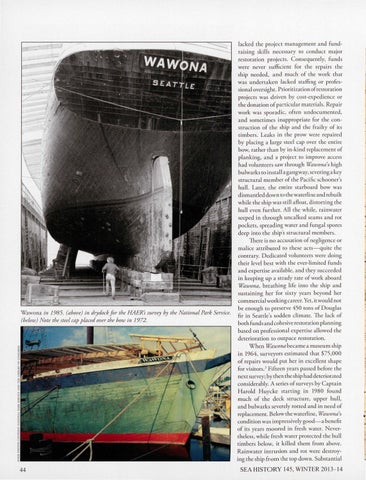Wawo na in 1985. (above) in drydock for the HAER 's survey by the National Park Service. (below) Note the steel cap placed over the bow in 1972.
44
lacked the project managem ent a nd fundraising skills necessary to conduct majo r restoration projects. Consequently, funds were never sufficient fo r the repairs the ship needed, .and much of the work that was undertaken lacked staffin g or professional oversight. Prioritization of restoration proj ects was driven by cost-expedience or the donation of particular m aterials. Repair work was spo radic, often undocumented, a nd sometimes inappropriate for the constructio n of the ship and the frailty of its timbers. Leaks in the prow we re repaired by placing a large steel cap over the entire bow, rather tha n by in-kind replacement of planking, and a project to improve access had volunteers saw thro ugh Wawona's high bulwa rks to install a ga ngway, severin g a key structural member of the Pacific schooner's hull. Later, the entire starboard bow was dism antled down to the waterline and rebuilt while the ship was still afloat, distorting the hull even furth er. A ll the while, rainwa ter seeped in through uncalked seams a nd ro t pockets, spreading water and fun gal spo res deep into the ship's structural members. There is no accusation of negligence or m alice attributed to these acts-quite the contra ry. D edicated volunteers were doing their level best with the ever-limited funds and expertise ava ilable, and rhey succeeded in keeping up a steady rate of work aboa rd Wawona, brea thing life into the ship a nd sustaining her for sixty years beyond her commercial wo rking career. Yer, it wo uld not be enough to preserve 450 tons of Douglas fir in Seattle's sodden climate. The lack of both funds and cohesive restoration planning based on profess ional expertise allowed the deterioration to outpace restoration. W hen Wawona became a museum ship in 1964, surveyo rs esrimared that $75,000 of repairs wo uld put her in excellent shape for visitors.3 Fifteen yea rs passed before the nexr survey; by rhen the ship had deteriorated considerably. A series of surveys by C aptain Harold Huycke starting in 1980 found much of the deck structure, upper hull , and bulwa rks severely rotted and in need of replacement. Below the waterline, Wawona's conditio n was impressively good- a benefit of its yea rs m oored in fresh water. N eve rtheless, while fresh water prorecred the hull timbers below, it killed them from above. Rainwater intrusion and rot were destroying the ship foom the top down. Substantial
SEA HJSTORY 145, WINTER 2013- 14
